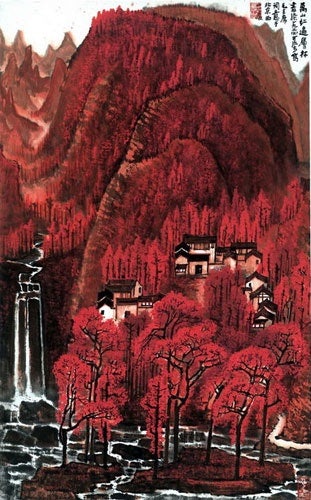Li Keran's “Wan Shan Hong Bian” Painted In 1964#

He may not be a household name outside of China (or even in most households in China), but this past weekend a painting by the late artist
Li Keran#
(李可染) (1907-1989) sold for a record-setting 293.25 million yuan (US$46 million) at the Beijing Poly spring auctions. As China Daily notes this week, Li's painting "Wan Shan Hong Bian" (万山红遍, "Thousands of Hills in A Crimsoned View"), painted in 1964 and inspired by a poem written by Mao Zedong in 1925, was purchased by "a domestic entrepreneur who began buying art two years ago." (Which really doesn't help narrow down the pool of possible buyers, since many of China's art collectors are still very new to the game.)
As Beijing Poly Executive Director, Zhao Xu, said of the purchase, "The sale tonight shows a stable Chinese art market, which keeps attracting newcomers to auction houses. The high price of Li's painting will definitely leverage the market of 20th-century Chinese painting."
Though sky-high sales figures are becoming a common occurrence at home-grown Chinese auction houses like
Beijing Poly#
and
China Guardian#
(as well as a smattering of much smaller houses), one of the more interesting aspects of this weekend's $46 million sale is the fact that the painting was sourced from overseas -- which undoubtedly was a selling point among local bidders. Over the past year, Chinese domestic auction houses have spent ever more time and energy setting up overseas outposts, not in the hopes of holding auctions in those countries but rather to function as sourcing centers to buy up Chinese artwork that had been sold to collectors or smuggled outside of the country in recent decades and (in some cases) centuries.
By this point, the international ambitions of China’s largest auction houses — China Guardian and Beijing Poly — are far from a mystery. Relative newcomers compared to the likes of Christie’s and Sotheby’s, China Guardian (est. 1993) and Beijing Poly (est. 2005) have quickly emerged as the world’s third and fourth-largest auction houses by feeding the exponential growth in demand for art and antiques in their native mainland China.

As the BBC pointed out this January, both auction houses have, in record time, dominated the Chinese contemporary and traditional art segments, with China Guardian taking in US$606 million at its autumn auctions in Beijing last November, besting the $412 million made by Sotheby’s at its Hong Kong auctions in October, as well as the $367 pulled in by Christie’s at its November Hong Kong auctions.
With demand for art and antiques only rising among China’s wealthy, both China Guardian and Beijing Poly have their eyes on becoming international players in the auction world. But unlike Sotheby’s and Christie’s, the ambitions we see among Chinese auction houses have less to do with holding sales around the world than they do with procuring items to sell back home. Last December, China Guardian opened its first office in New York, followed this March by Beijing Poly. But Beijing Poly has been more motivated than its older counterpart in searching for pieces to sell to Chinese collectors back home. This spring, as Artinfo reported in April, Beijing Poly reps traveled to 16 countries -- including the US and Australia -- on a worldwide sourcing tour aimed at returning "significant cultural pieces to the motherland" (at great cost to auction buyers).
